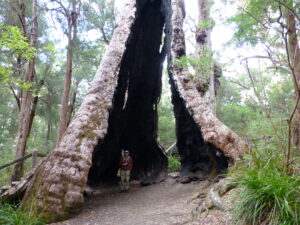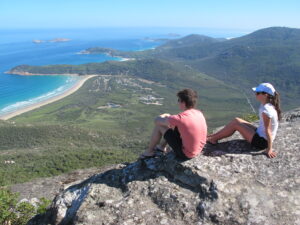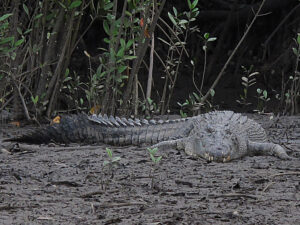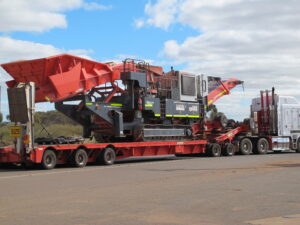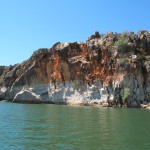
At the newly made hut operated by the Park service, we tried to check in for our three hour Darngku Heritage (pronounced darn-djoo) tour of what the maps call Geikie Gorge (pronounced geeky). Dozens of people wandered about, purchasing tickets and buying souvenir trinkets and hats. Apparently, like most visitors, they were here for the one hour Park service tour, a quick look at the natural features. That’s why we were directed instead to follow the signs down the path below us.
Shortly, we came upon a scruffy clearing, where a portly middle aged man sat leaning on a table. Near him, six chairs were positioned in front of two information panels. The radio in his flat-bed truck was broadcasting news of national politics and personal mayhem in Australia.
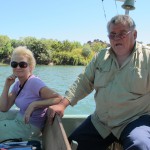
Bill was only our second guide from the local indigenous tribes during our trip to the Northern Territory and the Kimberley region. (Click here to read our post about the Mimbi Caves.) Like our guide at Mimbi, he too looked as much European as aboriginal, and was just as bonded to his land and his community. His grandmother, depicted on one of the panels, had played an important role in promoting communal interests early on. He was involved in a set of community businesses, including our gorge tour, so somehow we started talking about the problems he was having with his website developer. His children were now actively managing the land returned to his Bunuba tribe by the government.
Fortunately for us, during our three hours with Bill, he would soon take us personally and proudly into Bunuba culture, impressing us more with what he imparted than the attractions of the natural landscape that had brought us here.
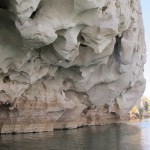
While we waited for any others to show up for our tour, the throng of Park cruise tourists bustled by. No one else joined us, so we ambled down to the dock where his boat looked a bit worn compared to the much larger and shinier flatboats that the Park was using. Open to the hot sun however, they were a lot less inviting than his roofed one.
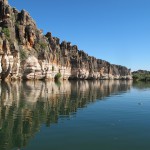
The gorge itself was engaging and attractive, with creamy scalloped and pock-marked sandstone walls dotted with fairy martin mudhouses. Its highlight was the Western Wall, a long, picturesque escarpment marked by rainbow-tinted bands that had once been an underwater reef millennia ago. All very beautiful, but not so deep or eye-popping as many of the gorges we had already seen in the Northern Territory during our trip.
Our host proved the main reason to be there. He spoke in detail of the natural history of the river as you can hear in this video:
He told of tribal legends that explained the river’s origins, features, and dangers. One small rock island, for example, was the old man who fell asleep forever there, and could bring harmful storms and waters to any that offended him.
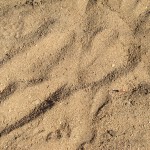
We beached on a wide sandy shoal opposite the Western Wall, and walked a half kilometer to a nearby cliff. Along the way, Bill pointed out tracks of lizards, wallabies and birds that we barely noticed. “Bush people look down as they walk, scanning the ground for signs of available food and possible dangers; not like you, looking up and ahead. That’s why we have so much trouble in cities, where we just don’t see the immediate threats – like cars.”
As we climbed the steep but manageable trail up the cliff, he warned us to go at our own pace. We’ve done a lot worse trekking than this, but we worried about him as, surprisingly nimble, he hauled his weighty frame up with us. Along the way, he pointed out a variety of plants, both useful for medicinal purposes and harmful. He showed us old coral still caught in deep niches from the Devonian past.
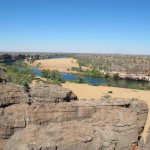
At the top, the deep blue river swung grandly away from us around the wide Wall, as a Parks boat puttered by. We yelled out; a barely diminished echo bounced back to us. We sniffed bush lemongrass used to cook fish or roll around in at night as an odor-masking cologne. Our fingers became sticky from a resinous plant used to make bush epoxy and trap animals (a few days later, we found more of it and pointed it out to some visitors passing by). He demonstrated how his people made an impromptu knife from certain kinds of rock. This was all practical knowledge that bush residents needed in order to survive amid the limited resources of the outback.
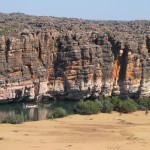
He also shared the more spiritual and cultural knowledge of the Bunuba people, such as their kindnesses to the dead. Traditionally they used smoke to guide the spirit of a dead person away from this world and protect the living from any evil in that spirit. If you had the same name as the dead person, you would lose it and have to come up with a new one: otherwise, calling out the name might summon the dead person back in an irritable mood. Within a few years of a death, other rituals would notify the dead that they could move on in peace as their relatives were doing just fine.
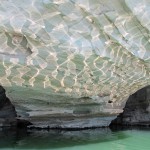
Heading back downriver, we talked about the elaborate kinship structure of indigenous tribes, bonds which European settlers ignored and trampled. He spoke of his many wives and his familial obligations to them, explaining with a grin that the wives of his brothers and cousins were as important to support as actual wives if need be. Their children were his children in that sense as well. Grandparents were expected to take care of children, monitoring and teaching them, for the simple reason that the parents were busier in making a living. As a result of such interwoven responsibilities, the community ensured the welfare of all its members.
He spoke of the obligations of strangers. Someone traveling in the land of another tribe would make his presence known so he could query the locals about sacred places he must not violate, food sources and threats – and they were obligated to help him. Traditionally, when a nomadic tribe moved on, they would leave a midden, a pile of the bones from animals they ate, so people new to the area would know about its resources.
Yet Bill could travel a long way without being a stranger. His familial connections, he said, stretched for thousands of kilometers in any direction, so he could usually find extended family obligated to let him couch surf while he stayed among them.
A few thousand kilometers of familial connections might not seem much to globetrotters. The powerful obligations to strangers and community might seem quaint. But the values that Bill taught us on the river transported us to a vision of a more congenial world. The brave old world values of the Bunuba still have much to tell us about relationships with each other and with the land.
(Also, for more pictures from Australia, CLICK HERE to view the slideshow at the end of the Australia itinerary page.)



